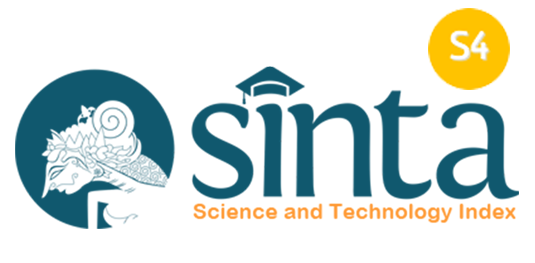A culture-based development of mathematics learning: A case on the Muhammad Cheng Hoo Mosque of Surabaya
Abstract
Learning mathematics in schools aim to make students able to make mathematics as a solution or approach in simplifying or solving daily problems. To achieve this goal, it is necessary to have a culture-based mathematics learning which expected to be able to help students understand and master mathematics better. The purpose of this study is to identify the mathematical elements contained in the ornament and architecture of the Muhammad Cheng Hoo Mosque in Surabaya. This research is qualitative research with an ethnographic approach. Data collected by using a literature study, observation, documentation, and interviews. Data analysis is classified into several stages, namely domain and taxonomic analysis, componential analysis, and cultural theme analysis. The results showed that there are mathematical elements in the ornament and architecture of the Muhammad Cheng Hoo Mosque in Surabaya included the concepts of plane geometry, solid geometry, and transformational geometry. Mathematical elements in this mosque may be used as material for the development of culture-based mathematics learning at the primary and secondary school levels.
Keywords
Full Text:
PDFReferences
Abi, A. M. (2016). Integrasi etnomatematika dalam kurikulum matematika sekolah. JPMI (Jurnal Pendidikan Matematika Indonesia), 1(1), 1–6. https://doi.org/10.26737/jpmi.v1i1.75
Acharya, B. R. (2017). Factors affecting difficulties in learning mathematics by mathematics learners. International Journal of Elementary Education, 6(2), 8–15. https://doi.org/10.11648/j.ijeedu.20170602.11
Agustin, R. D., Ambarawati, M., & Kartika, E. D. (2018). Development of mathematical learning instruments based on ethnomathematics in character education learning. International Journal on Teaching and Learning Mathematics, 1(1), 24–30. https://doi.org/10.18860/ijtlm.v1i1.5353
Alangui, W. V. (2010). Stone walls and water flows: Interrogating cultural practice and mathematics. The University of Auckland.
Anggo, M. (2011). Pemecahan masalah matematika kontekstual untuk meningkatkan kemampuan metakognisi siswa. Edumatika, 1(2), 35–42. https://online-journal.unja.ac.id/index.php/edumatica/article/view/182
Anita, I. W. (2014). Pengaruh kecemasan matematika (mathematics anxiety) terhadap kemampuan koneksi matematis siswa SMP. Infinity Journal, 3(1), 125–132. https://doi.org/10.22460/infinity.v3i1.43
Asnawi, M. H., Annisa, H., Ulum, M. M., Arofah, N. L., & Hendrawati, N. E. (2022). Ethnomathematic exploration at Agung Jami’ Malang Mosque in improving students’ mathematic problem solving ability. IndoMath: Indonesia Mathematics Education, 5(1), 13–21. https://doi.org/10.30738/indomath.v5i1.13
Căprioară, D. (2015). Problem solving - Purpose and means of learning mathematics in school. Procedia - Social and Behavioral Sciences, 191, 1859–1864. https://doi.org/10.1016/j.sbspro.2015.04.332
D’Ambrosio, U., & D’Ambrosio, B. S. (2013). The role of ethnomathematics in curricular leadership in mathematics education. Journal of Mathematics Education at Teachers College, 4, 19–25. https://doi.org/https://doi.org/10.7916/jmetc.v4i1.767
d’Entremont, Y. (2015). Linking mathematics, culture and community. Procedia - Social and Behavioral Sciences, 174(1999), 2818–2824. https://doi.org/10.1016/j.sbspro.2015.01.973
Endrayadi, E. C. (2019). Pendirian Masjid Cheng Ho: Sebuah simbol identitas Cina Muslim dan komoditas wisata religius di Surabaya. Humaniora, 1(2), 171–186.
Fajriah, N., & Suryaningsih, Y. (2021). Ethnomathematics of the Jami Mosque Jingah River as a source mathematics learning. Journal of Physics: Conference Series, 1760(1), 1–7. https://doi.org/10.1088/1742-6596/1760/1/012025
Friansah, D., & Yanto, Y. (2020). The exploration of ethnomathematics in the cultural heritage of musi rawas regency through ethnographic studies. Journal of Physics: Conference Series, 1521(3), 1–6. https://doi.org/10.1088/1742-6596/1521/3/032101
Gravemeijer, K., Stephan, M., Julie, C., Lin, F. L., & Ohtani, M. (2017). What mathematics education may prepare students for the society of the future? International Journal of Science and Mathematics Education, 15, 105–123. https://doi.org/10.1007/s10763-017-9814-6
House, J. D. (2006). Mathematics beliefs and achievement of elementary school students in Japan and the United States: Results from the Third International Mathematics and Science Study. Journal of Genetic Psychology, 167(1), 31–45. https://doi.org/10.3200/GNTP.167.1.31-45
Ilmiyah, N. F., Annisa, A., Fitriyah, A., & Vebyanti, B. S. (2020). Analisis motif anyaman dan aktivitas fundamental matematis dalam seni menganyam di Desa Plaosan Kabupaten Kediri. Alifmatika: Jurnal Pendidikan Dan Pembelajaran Matematika, 2(1), 92–104. https://doi.org/10.35316/alifmatika.2020.v2i1.92-104
Ilmiyah, N. F., Rofiqoh, I., & Sholihah, R. M. N. (2020). Analisis etnomatematika dalam seni ornamen dan rancang bangun Masjid Al-Khalid Kediri sebagai pengembangan pembelajaran matematika berbasis budaya. In Prosiding Seminar Nasional Pendidikan Dan Ilmu Matematika (SENANDIKA) (pp. 332–341).
Kastolani, N. M. (2021). Identifying ethnomathematics in the Old Mosque of Tosora. Southeast Asian Mathematics Education Journal, 11(2), 107–118. https://doi.org/10.46517/seamej.v11i2.112
Klee, H. L., Buehl, M. M., & Miller, A. D. (2021). Strategies for alleviating students’ math anxiety: Control-value theory in practice. Theory into Practice, 61(1), 49–61. https://doi.org/10.1080/00405841.2021.1932157
Kristanti, F., Ainy, C., Shoffa, S., Khabibah, S., & Amin, S. M. (2018). Developing creative-problem-solving-based student worksheets for transformation geometry course. International Journal on Teaching and Learning Mathematics, 1(1), 13–23. https://doi.org/10.18860/ijtlm.v1i1.5581
Maloney, E. A., & Beilock, S. L. (2012). Math anxiety: Who has it, why it develops, and how to guard against it. Trends in Cognitive Sciences, 16(8), 404–406. https://doi.org/10.1016/j.tics.2012.06.008
Markovits, Z., & Forgasz, H. (2017). “Mathematics is like a lion”: Elementary students’ beliefs about mathematics. Educational Studies in Mathematics, 96(1), 49–64. https://doi.org/10.1007/s10649-017-9759-2
Mazana, M. Y., Montero, C. S., & Casmir, R. O. (2018). Investigating students’ attitude towards learning mathematics. International Electronic Journal of Mathematics Education, 14(1), 207–231. https://doi.org/10.29333/iejme/3997
Muchlis, A. F. (2009). Masjid: Bentuk manifestasi seni dan kebudayaan. El-Harakah, 11(1), 1–16.
Palhares, P. (2012). Mathematics education and ethnomathematics. a connection in need of reinforcement. REDIMAT - Journal of Research in Mathematics Education, 1(1), 79–92. https://doi.org/10.4471/redimat.2012.04
Patri, S. F. D., & Heswari, S. (2021). Development of ethnomathematic-based on mathematics e-module to improve students’ logical thinking skills. AIP Conference Proceedings, 2330, 1–7. https://doi.org/10.1063/5.0043250
Purniati, T., Turmudi, & Suhaedi, D. (2020). Ethnomathematics: Exploration of a mosque building and its ornaments. Journal of Physics: Conference Series, 1521(3), 1–7. https://doi.org/10.1088/1742-6596/1521/3/032042
Purniati, Tia, Turmudi, T., Juandi, D., & Suhaedi, D. (2021). Ethnomathematics exploration of the Masjid Raya Bandung ornaments in transformation geometry materials. Journal of Medives : Journal of Mathematics Education IKIP Veteran Semarang, 5(2), 235–243. https://doi.org/10.31331/medivesveteran.v5i2.1639
Putra, R. Y., Wijayanto, Z., & Widodo, S. A. (2020). Etnomatematika: Masjid Soko Tunggal dalam pembelajaran geometri 2D. Jurnal Riset Pendidikan Dan Inovasi Pembelajaran Matematika (JRPIPM), 4(1), 10–22. https://doi.org/10.26740/jrpipm.v4n1.p10-22
Radiusman, Novitasari, S., Nurmawanti, I., Fauzi, A., & Simanjuntak, M. (2021). Ethnomathematics: Mathematical values in Masjid Agung Demak. AIP Conference Proceedings, 2331(April), 1–7. https://doi.org/10.1063/5.0041639
Risdiyanti, I., & Prahmana, R. C. I. (2020). Ethnomathematics (Teori dan implementasinya: Suatu pengantar) (R. C. I. Prahmana (ed.); 1st ed.). UAD Press.
Rosa, M., D’Ambrósio, U., Orey, D. C., Shirley, L., Alangui, W. V., Palhares, P., & Gavarrete, M. E. (2016). Current and future perspectives of ethnomathematics as a program. Springer Open. https://doi.org/10.1007/978-3-319-30120-4 ISSN
Rosa, M., & Gavarrete, M. E. (2017). An ethnomathematics overview: An introduction (pp. 3–19). https://doi.org/10.1007/978-3-319-59220-6_1
Rubinsten, O., & Tannock, R. (2010). Mathematics anxiety in children with developmental dyscalculia. Behavioral and Brain Functions, 6(46), 1–13. https://doi.org/10.1186/1744-9081-6-46
Saragih, S., & Napitupulu, E. (2015). Developing student-centered learning model to improve high order mathematical thinking ability. International Education Studies, 8(6), 104–112. https://doi.org/10.5539/ies.v8n6p104
Saragih, S., Napitupulu, E. E., & Fauzi, A. (2017). Developing learning model based on local culture and instrument for mathematical higher order thinking ability. International Education Studies, 10(6), 114–122. https://doi.org/10.5539/ies.v10n6p114
Simamora, R. E., Saragih, S., & Hasratuddin, H. (2018). Improving students’ mathematical problem solving ability and self-efficacy through guided discovery learning in local culture context. International Electronic Journal of Mathematics Education, 14(1), 61–72. https://doi.org/10.12973/iejme/3966
Spradley, J. P. (1997). Metode Etnografi (Penerjemah: Misbah Zulfa Elizabeth). Tiara Wacana.
Susanti, E., Ulya, N. M., & Asnawi, M. H. (2022). Ethnomathematics : Graph of architecture Masjid Agung Kediri. Advances in Social Science, Education and Humanities Research, 644(Islage 2021), 324–328.
Tanaja, T., & Tulistyantoro, L. (2017). Kajian ikonografi ornamen pada interior Masjid Cheng Hoo Surabaya. Jurnal Intra, 5(2), 174–181.
Titisari, H., & Salamun. (2015). Masjid Cheng Ho Surabaya seni bangunan, ornamen, dan kaligrafi. Jurnal Pendidikan Seni Rupa, 3(2), 27–33.
Tsai, Y. M., Kunter, M., Lüdtke, O., Trautwein, U., & Ryan, R. M. (2008). What makes lessons interesting? The role of situational and individual factors in three school subjects. Journal of Educational Psychology, 100(2), 460–472. https://doi.org/10.1037/0022-0663.100.2.460
Young, C. B., Wu, S. S., & Menon, V. (2012). The neurodevelopmental basis of math anxiety. Psychological Science, 23(5), 492–501. https://doi.org/10.1177/0956797611429134
DOI: https://doi.org/10.18860/ijtlm.v4i1.10980
Refbacks
- There are currently no refbacks.
Copyright (c) 2022 Nur Fadilatul Ilmiyah

This work is licensed under a Creative Commons Attribution-NonCommercial-ShareAlike 4.0 International License.
Indexed by :
.png)
.jpg)
.png)

.jpg)




